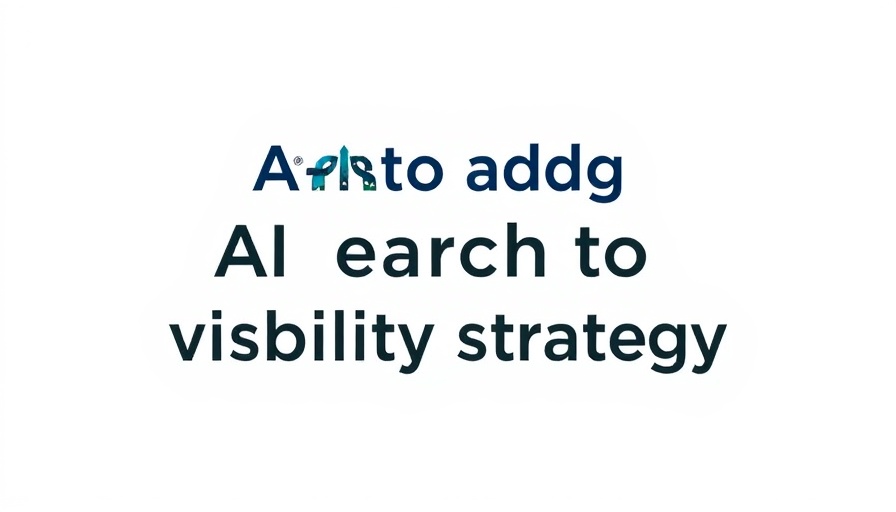
Understanding the Shift in Search Habits
The advent of generative artificial intelligence (AI) is revolutionizing how we interact with the digital landscape. Recent studies reveal a notable trend: 20% of web users have switched their primary search platforms in just the last year, with an impressive 78% experimenting with generative AI in search. These statistics underscore a critical reality for businesses: the tools and methods for online discovery are evolving.
Impact of AI on SEO Strategies
As AI continues to shape user interactions, SEO practices must evolve accordingly. The integration of AI chatbots and AI-generated summaries in platforms like Google signifies a paradigm shift. Brands must adapt their strategies to remain applicable and visible. The question remains: how should businesses recalibrate their SEO approaches to align with AI advancements? This is where a checklist from SEMRush may become invaluable, providing practical steps for integrating AI discovery into traditional SEO frameworks.
Trending SEO Techniques for an AI-Driven Future
Because the AI landscape is constantly changing, brands need to be proactive in their SEO efforts. Here are some actionable techniques to consider:
- Optimization for AI Insights: Ensuring that your content can be effectively interpreted by AI algorithms is essential. This means using clear, concise language and structured data to provide search engines with the context needed to categorize and understand your content.
- Focus on User Intent: Understanding and catering to user intent is becoming increasingly critical as AI evolves. Businesses should analyze search queries to determine what users genuinely seek and craft content that addresses those needs directly.
- Quality Content Creation: The heart of SEO remains unchanged: content quality. Businesses must produce valuable, engaging material that aligns with user queries and incorporates relevant keywords that are optimized for AI.
Future Predictions: The Growth of AI in SEO
The growth of generative AI is likely to keep these changes dynamic. As more users familiarize themselves with AI-driven tools, businesses must remain agile and adapt to new trends in the SEO space. Enhanced capabilities in AI could mean even more sophisticated analysis of user behavior and preferences, which might lead to increasingly personalized search results.
Counterarguments: Skepticism Around AI in Search
Despite the rapid advances in AI, not all experts agree that the changes are wholly beneficial. Concerns have been raised regarding the reliability of AI outputs and the potential for misinformation. Businesses must navigate these complexities, balancing the need to adopt AI tools while maintaining high standards of accuracy and trustworthiness in their content.
Distinct Benefits of Adapting to AI Changes
Aligning SEO practices with the evolving AI landscape positions businesses ahead of their competition. Companies that ignore these shifts may risk falling behind as search habits change. The benefits of adapting to these changes include:
- Increased Visibility: By optimizing for new AI features, brands can enhance their visibility in search results, attracting more potential customers.
- Enhanced User Experience: Tailored content using AI insights contributes to a more engaging user experience, fostering brand loyalty and client retention.
- Long-term Growth: Proactive adaptation ensures businesses remain relevant, laying the groundwork for sustained growth in an increasingly digital market.
Practical Steps Forward: Implementing Effective AI-Driven SEO
Incorporating AI discovery into your SEO strategy doesn’t require a complete overhaul. Here are some practical insights:
- Start small: Identify specific areas of your SEO that can benefit from AI, such as keyword research or content creation.
- Utilize available tools: Leverage AI-driven analytics tools to gain insights into user behavior patterns and adapt your content strategy accordingly.
- Stay informed: Engage in continuous learning about AI developments and their implications for search. Follow trusted sources and consider joining professional groups that focus on SEO and AI innovations.
Closing Thoughts: Embracing the Evolution of SEO and AI
As a business owner, understanding the impact of AI on search habits and SEO is crucial. By aligning your strategies with these evolving trends, you not only enhance your visibility but also pave the way for your business’s growth. It’s an intimidating yet exciting time filled with opportunities. Don’t wait to adapt; the AI-driven future is here, and your brand must make its mark in the new digital landscape.
For those looking to remain competitive in this rapidly changing environment, consider implementing these AI-driven SEO practices today. Your brand’s future depends on it!
 Add Row
Add Row  Add
Add 




Write A Comment